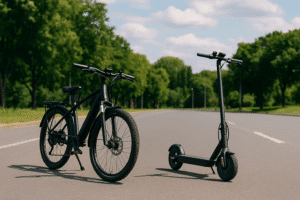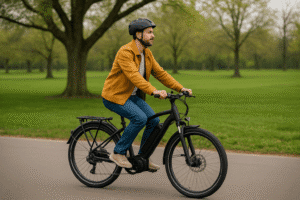If you’re wondering how long it takes to charge an electric bike, the answer usually falls between 3 and 6 hours.
The actual time depends on the battery size, charger speed, and how much charge is left when you plug it in.
Key Takeaways:
- Most e-bikes charge in 3–6 hours.
- Battery size and charger output impact total charging time.
- Charging up to 80% is faster and better for battery health.
- Fast charging is possible but may reduce battery lifespan.
- Storing batteries at 40–60% extends their life.
How Long Does It Take to Charge an Electric Bike?
Most e-bikes take 3 to 6 hours to fully charge, depending on battery size and charger speed. Smaller batteries (250-400Wh) charge in 2-3 hours, while larger ones (750Wh+) can take 5-8 hours.
Fast chargers can cut charging time, but not all batteries support them. Many e-bikes slow charging after 80% to prevent overheating, so topping up to 80% is much quicker than waiting for a full charge.
Charging time also depends on how much charge is left when you plug in. A half-full battery charges faster than one drained to 0%. Keeping your battery between 30-80% helps maintain its lifespan and reduces wear over time.
Electric Bike Charging Time Comparison by Battery Size
Charging time depends on three things: battery size, charger power, and starting charge level.
| Battery Size | Standard Charger (2A–3A) | Fast Charger (4A–6A) |
|---|---|---|
| 250–400Wh | 2–3 hours | 1–2 hours |
| 500–700Wh | 3–5 hours | 2–3 hours |
| 750–1000Wh+ | 5–8 hours | 3–4 hours |
What Factors Affect E-Bike Charging Time?
Charging time isn’t the same for every e-bike. A few key factors can speed it up or slow it down.
Battery Size & Capacity
E-bike batteries come in different sizes, measured in watt-hours (Wh). A small 250Wh battery charges much faster than a 750Wh battery, simply because there’s less energy to replenish.
- 250Wh – 400Wh → About 2-3 hours
- 500Wh – 700Wh → Around 3-5 hours
- 750Wh+ → Can take 5-8+ hours
If you have a dual-battery setup, expect even longer charging times unless you have two chargers running at once.
Charger Type & Power Output
Not all chargers are the same. The higher the amp rating, the faster the charge.
- Standard charger (2A-3A): Slower, but easier on the battery.
- Fast charger (4A-6A): Cuts charging time in half, but generates more heat.
- High-powered chargers (8A+): Used for high-end e-bikes but can reduce battery lifespan over time.
Always check if your battery supports fast charging before using a more powerful charger.
Charging From Different Battery Levels
Charging from empty (0%) to full (100%) takes the longest. If your battery is at 50%, charging up is much quicker.
Many e-bike batteries charge to 80% pretty fast, then slow down for the last bit. This is intentional—it helps protect the battery from overheating and extends its life.
Battery Age & Condition
New batteries charge faster and hold power better. As your battery ages, it takes longer to charge and won’t hold as much energy. A battery that once lasted 50 miles might only get you 35 after a few years.
Read more: How to reset e-bike batteries
Temperature & Environment
Charging in extreme heat or cold can mess with charging speed.
- Cold weather (below 32°F/0°C): Slows down charging significantly.
- Hot weather (above 100°F/38°C): Can cause overheating and long-term damage.
- Best charging temperature: 50-77°F (10-25°C) in a cool, dry space.
How to Charge an E-Bike Battery Properly
Here’s how to charge your e-bike battery the right way:
- Turn off the bike before charging
- Use the original charger that came with your e-bike
- Plug the charger into the battery first, then into the wall
- Charge in a cool, dry place away from direct sunlight
- Unplug when the battery is around 80-90% for better longevity
- Avoid leaving the battery fully drained for long periods
- Store at 40-60% charge if not riding for weeks/months
Now, let’s break these down a little more.
1. Turn Off the Bike Before Charging
Some e-bikes won’t charge if they’re still powered on, but even if yours does, it’s a good habit to turn it off first. This prevents any background power usage from slowing down the charge and avoids any electrical hiccups while the battery is plugged in.
It’s a simple step that helps make sure the battery gets the full charge without interruptions.
2. Use the Right Charger
Not all chargers are created equal. Grabbing a random charger that “seems” to fit can damage your battery or, worse, cause a fire hazard. Stick with the charger that came with your e-bike or a verified replacement with the same voltage and amperage.
If you’re unsure, check your e-bike manual or the manufacturer’s website—guesswork isn’t worth the risk.
3. Plug in the Battery First, Then the Wall Outlet
It might seem like a small thing, but the order in which you plug in your charger matters. Connecting the charger to the battery first, then plugging it into the wall, helps prevent sudden power surges that could harm the charger or the battery.
When everything is plugged in, check for an indicator light to make sure the charging process has started.
4. Charge in a Cool, Dry Place
Batteries don’t like extreme temperatures. Charging your e-bike in a hot garage or under direct sunlight can cause overheating, while a freezing cold space can slow down the charge or even damage the battery over time.
A dry, room-temperature spot is best—think somewhere inside your house or a shaded garage.
5. Unplug at 80-90% for Longer Battery Life
Most e-bike batteries perform best when they aren’t constantly drained to 0% or topped off to 100%. Charging up to 80-90% instead of full capacity helps extend the battery’s life.
Many e-bikes slow down charging after 80% anyway, so unplugging at that point saves time and helps keep the battery healthy for longer.
6. Don’t Let It Sit at 0% for Too Long
Leaving your battery fully drained for weeks or months isn’t a good idea. When a lithium-ion battery stays at 0% for too long, it can go into deep discharge mode, making it harder (or impossible) to charge again.
If you’re not riding for a while, charge it to 40-60% before storing it, and top it up every few weeks to keep it in good shape.
Can You Charge an E-Bike Faster?

Yes, but there are a few things to keep in mind. If you’re in a hurry, there are ways to reduce charging time, but some come with risks.
Ways to Speed Up Charging:
- Use a fast charger (if your e-bike battery supports it). Fast chargers have a higher output and can cut charging time in half.
- Charge before the battery gets too low. Waiting until the battery is at 10% or lower takes longer to charge than topping up from 30-40%.
- Keep the battery at room temperature while charging. Cold temperatures slow things down, and excessive heat isn’t great for battery health either.
- Charge with multiple chargers (for e-bikes with dual batteries). Some high-end e-bikes allow you to charge both batteries at the same time, cutting the wait in half.
Fast Charging Risks:
- More heat = more wear and tear. Fast charging generates extra heat, which can shorten the battery’s lifespan if done too often.
- Overheating dangers. If a battery gets too hot while charging, it could shut down or, in rare cases, become a fire hazard.
- Not all e-bike batteries support fast charging. If your battery isn’t built for it, forcing it to fast charge could damage the cells. Always check before using a faster charger.
If you need a quick charge, getting to 80% is usually fast enough; it’s the last 20% that takes the longest. If you can plan your rides around this, you’ll spend less time waiting and more time riding.
How Long Does an E-Bike Battery Last?
An e-bike battery lasts 3 to 5 years or 500 to 1,000 charge cycles before losing capacity. After that, it still works but won’t hold as much charge, leading to shorter rides and more frequent charging.
Lifespan depends on how you charge and store it. Keeping it 30-80% charged, avoiding extreme temperatures, and using the right charger can extend its life. Throttle-heavy riding drains it faster, while steady pedaling with assist helps it last longer.
Daily riders may notice a drop in 3-4 years, while occasional riders can get 5-6 years with good care. When range declines, replacing the battery is usually the best option.
Pro Tips to Extend Battery Life & Optimize Charging
Want your e-bike battery to last as long as possible? Small habits can make a big difference.
- Charge before it drops below 20-30% to prevent deep discharge.
- Unplug at 80-90% instead of always charging to 100%.
- Store at 40-60% charge if you won’t be riding for weeks or months.
- Use the original charger to avoid voltage mismatches.
- Keep the battery in a cool, dry place. Avoid extreme heat or cold.
- Don’t leave it plugged in overnight for days; it won’t explode, but it can shorten its lifespan.
- Pedal more, throttle less; the less strain on the battery, the longer it lasts.
Final Words
Charging an e-bike usually takes 3-6 hours, but it depends on the battery size, charger type, and temperature. If you want to charge faster, a compatible fast charger can help, but it may reduce battery lifespan over time.
Taking care of your battery saves you money in the long run. Charge it the right way, avoid extreme temperatures, and don’t let it sit at 0% for too long.
With proper care, your e-bike battery can last years before needing a replacement—keeping you riding longer with fewer hassles.
FAQs
Can I charge my e-bike overnight?
Yes, but it’s not the best idea. While most modern batteries stop charging when full, keeping it plugged in for too long can generate heat and wear it out faster. If you charge overnight, use a timer plug to shut off power after 4-5 hours.
Should I fully drain my battery before charging?
No! Unlike old-school batteries, lithium-ion ones prefer partial charges. Keeping the charge between 30-80% helps extend battery life. Running it down to 0% too often can damage the cells.
Can I use any charger to charge my e-bike battery?
No. Using the wrong charger can damage the battery or even cause a fire. Always use the manufacturer’s charger or a verified replacement with the same voltage and amperage.
What happens if I overcharge my e-bike battery?
Most modern e-bike batteries have auto shut-off, but leaving it plugged in for too long repeatedly can degrade battery health over time. It’s best to unplug it once it reaches 80-90% unless you’re about to ride soon.
Can I ride my e-bike while charging?
No. E-bikes won’t let you ride while plugged in. Even if they did, it’s not safe—charging puts strain on the system, and moving the bike could disconnect or damage the charging port.
Michael Josh is a hands-on e-bike tester and reviewer at BoltBikers, known for putting every model through real-world rides before sharing his thoughts. With a sharp eye for performance, comfort, and build quality, he helps the team choose which bikes are worth featuring. Backed by years of experience in tech and gear reviews, Michael brings trusted, honest insights to help readers find the right e-bike for their needs.








